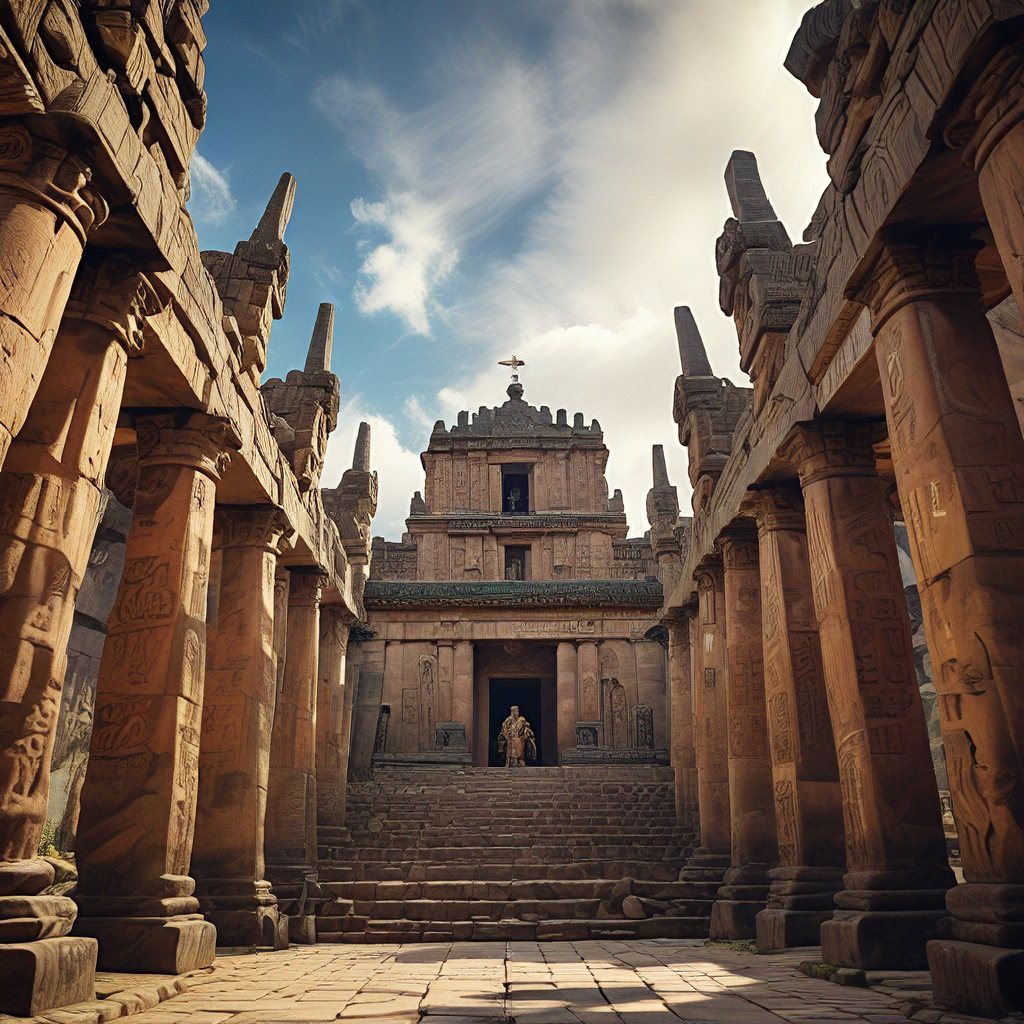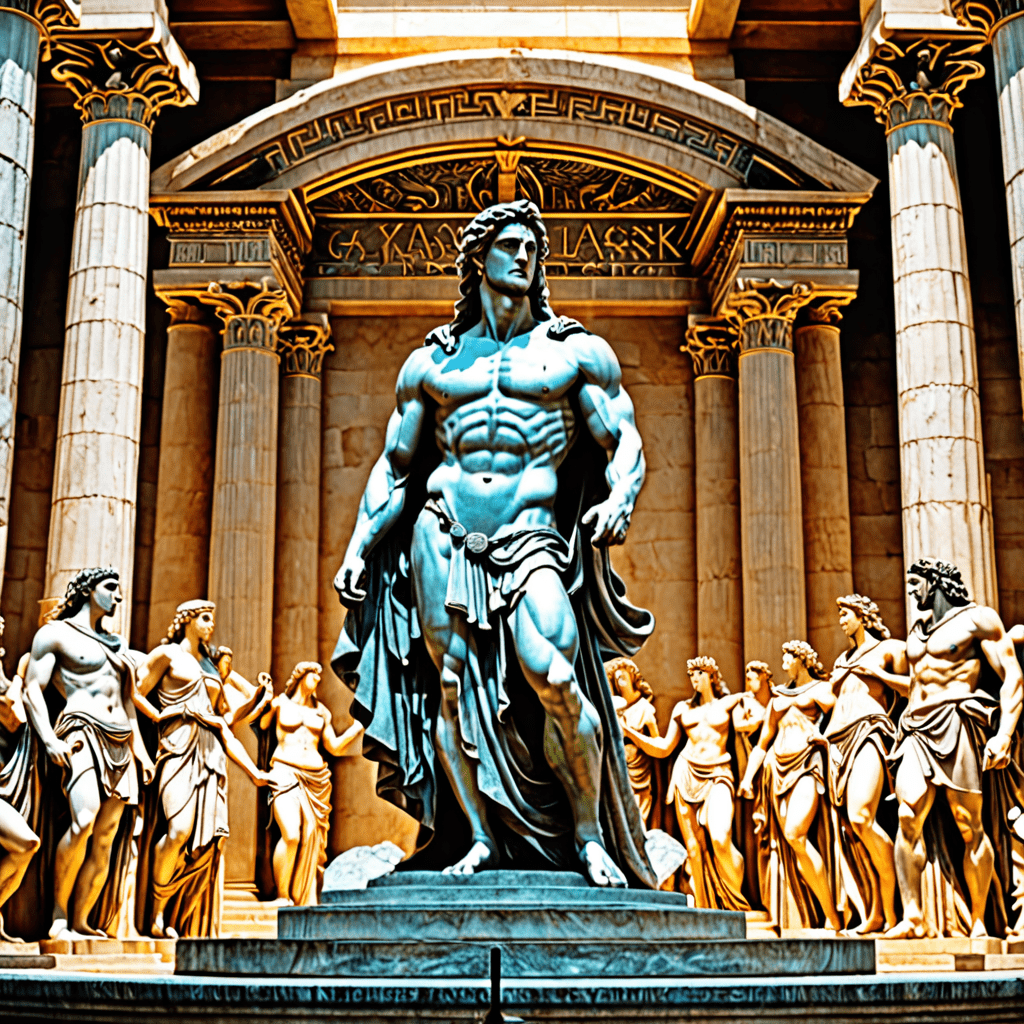The Incan Myth of the Temple of Wiracocha: Monument of Power
The Incan Empire, known for its intricate architecture, advanced agricultural practices, and complex social structure, left behind a rich legacy of myths and legends that reveal their worldview and beliefs. Among these, the myth of the Temple of Wiracocha stands out as a crucial testament to the Incan concept of power, divine authority, and cosmic order. This myth, deeply entwined with the empire's origins and the figure of its most important deity, Wiracocha, highlights the temple's sacred role and its enduring symbolism in Incan culture.
The God of Creation: Wiracocha in Inca Cosmology
In Incan mythology, Wiracocha, also known as Viracocha, holds a central position as the creator deity responsible for bringing life to the universe. He is portrayed as a powerful and benevolent figure who, according to Incan beliefs, emerged from Lake Titicaca, the sacred lake in the Andes, and created the world, the stars, the sun, the moon, and humankind. Wiracocha is often depicted as a bearded man holding a staff and a scepter, symbolizing his authority and power over the cosmos. He is considered the ultimate source of creation and the source from whom all Incan emperors derived their legitimacy.
The Temple of Wiracocha: A Sacred Site of Power and Authority
The Temple of Wiracocha, dedicated to this powerful deity, was a sacred site of immense importance within the Incan Empire. Located at the heart of the capital city of Cuzco, the temple was a physical manifestation of Incan belief in Wiracocha's divine authority and the emperor's role as his chosen representative. It served as a hub for religious ceremonies, rituals, and political gatherings, symbolizing the interconnectedness between the divine realm and the human world. The temple's construction, architectural grandeur, and intricate details reflected the Incan desire to create a physical space that would embody Wiracocha's power and inspire awe and reverence in the hearts of the people.
The Origins of the Myth: A Narrative of the Incan Origins and Divine Intervention
The Incan myth of the Temple of Wiracocha is intricately linked to the empire's origins and the divine intervention that, according to their belief, guided their rise to power. The myth recounts the story of how Wiracocha, angered by the wickedness of the ancient inhabitants of the land, decided to destroy them with a great flood. However, he spared a few virtuous individuals who would later become the ancestors of the Incas. This narrative connects the Incan people to Wiracocha's divine plan and establishes their legitimacy as the chosen people destined to rule over the land.
The Temple as a Symbol of Divine Authority: The Incan Emperor as the Chosen Representative of Wiracocha
The Temple of Wiracocha served as a potent symbol of the Incan emperor's divine authority. It was believed that the emperor was chosen by Wiracocha to rule over the land and uphold the cosmic order. The temple's presence in the heart of the capital city emphasized the emperor's connection to the divine and reinforced the legitimacy of his rule. The emperor's role as Wiracocha's representative was further solidified through elaborate rituals and ceremonies performed at the temple, where he would offer sacrifices and communicate with the deity. The temple, therefore, served as a physical manifestation of the emperor's divine mandate and the source of his legitimacy in the eyes of his people.
The Temple’s Role in Ritual and Ceremony: Connecting the Divine and Human Realms
The Temple of Wiracocha was not just a building; it was a living space where the Incan people connected with the divine realm. The temple hosted various rituals and ceremonies that aimed to maintain the cosmic order, ensure good harvests, and seek guidance from Wiracocha. These ceremonies involved offerings, sacrifices, music, dance, and elaborate costumes, all designed to appease the deity and strengthen the bond between the human and divine spheres.
The most important ceremony was the Inti Raymi, the Festival of the Sun, held during the winter solstice. This celebration involved processions, music, and elaborate offerings to the sun god Inti, considered Wiracocha's son. The Inti Raymi was a powerful reminder of the interconnectedness of the Incan people with the natural world and their reliance on Wiracocha's divine favor. The temple was the stage for these rituals, providing a sacred space where the Incan people could engage with their divine patron and seek his blessings.
Archaeological Evidence and the Temple’s Historical Significance
While the exact location of the Temple of Wiracocha remains a topic of debate among archaeologists, the ruins of numerous structures and artifacts found in Cuzco provide evidence of its existence and importance. The archaeological evidence reveals the temple's impressive size, intricate construction, and the presence of numerous religious symbols. Excavations have uncovered remnants of stone walls, plazas, and shrines, indicating the temple's complexity and grandeur. The discovery of ceramics, textiles, and other artifacts adorned with images of Wiracocha further confirms the temple's dedication to this powerful deity.
The archaeological evidence offers a glimpse into the temple's significance within the Incan social and religious fabric. It underscores its role as a focal point for ceremonies, rituals, and the expression of religious beliefs. The temple's physical remains offer a tangible link to the past, allowing us to understand the Incan people's worldview and their profound reverence for Wiracocha.
The Temple as a Monument to the Incan Empire’s Power and Majesty
The Temple of Wiracocha served as a powerful symbol of the Incan Empire's power and majesty. Its impressive size, intricate construction, and privileged location in the heart of Cuzco reflected the empire's wealth, architectural prowess, and cultural sophistication. The temple was a testament to the Incan people's ability to create a magnificent space that embodied their beliefs, values, and connection to their divine patron. The temple's grandeur inspired awe and reverence in the hearts of the Incan people, reinforcing their sense of national identity and collective purpose.
The temple's legacy extended beyond its physical presence. Its story resonated through generations of Incan people, shaping their understanding of power, authority, and the divine. It served as a reminder of the empire's greatness and its enduring connection to Wiracocha, the creator deity. The temple's enduring symbolism ensured that even after the fall of the empire, the myth of Wiracocha and his sacred temple continued to resonate, shaping the cultural identity and spiritual beliefs of the descendants of the Incan people.
The Temple’s Legacy: The Myth as a Source of Inspiration and Identity
The myth of the Temple of Wiracocha continues to inspire and resonate with people today. It offers a valuable window into the Incan civilization, their beliefs, and their worldview. The myth's enduring appeal lies in its ability to connect people to a rich history, a powerful deity, and a sense of national identity. It reminds us of the power of myths and legends to shape our understanding of the world and our place within it.
The myth serves as a source of inspiration for artists, writers, and historians seeking to explore the rich cultural heritage of the Incan people. It's a reminder of the human capacity for creativity, ingenuity, and religious devotion. The myth also serves as a valuable tool for understanding the complexity of pre-Columbian societies and the rich tapestry of human belief systems.
Modern Interpretations and Theories: Exploring the Temple’s Meaning in Contemporary Society
In contemporary society, the myth of the Temple of Wiracocha continues to be analyzed and interpreted through various lenses. Some scholars argue that the myth reflects the Incan people's desire to establish a sense of order and stability in a world filled with uncertainty. Others view the myth as a reflection of the Incan emperor's power and his ability to manipulate religious beliefs to maintain control over his people.
The myth also raises questions about the relationship between religion, power, and the construction of national identity. The temple's role in shaping the Incan worldview and fostering a sense of unity among the people highlights the power of religious beliefs to influence social cohesion and political structures.
The myth's enduring relevance suggests that the human need to understand the cosmos, find meaning in life, and connect with something greater than ourselves remains a constant across cultures and time. The Temple of Wiracocha, as a symbol of the Incan people's religious beliefs and their connection to their divine patron, continues to inspire curiosity and spark debate in the modern world.
FAQ
What is the Temple of Wiracocha?
The Temple of Wiracocha was a sacred site in the Incan Empire, dedicated to the creator god Wiracocha. It was located in the heart of the Incan capital city of Cuzco and served as a hub for religious ceremonies, rituals, and political gatherings.
Who was Wiracocha?
Wiracocha was the most important deity in Incan mythology. He was believed to be the creator of the universe, the stars, the sun, the moon, and humankind. He was often depicted as a bearded man holding a staff and a scepter, symbolizing his authority and power over the cosmos.
What was the significance of the Temple of Wiracocha?
The Temple of Wiracocha was a physical manifestation of Incan belief in Wiracocha's divine authority and the emperor's role as his chosen representative. It was a powerful symbol of the Incan Empire's power, majesty, and connection to the divine realm.
What archaeological evidence supports the existence of the Temple of Wiracocha?
Archaeological excavations in Cuzco have uncovered remnants of stone walls, plazas, and shrines, indicating the presence of a large and complex temple. The discovery of ceramics, textiles, and other artifacts adorned with images of Wiracocha further confirms the temple's dedication to this powerful deity.
What is the legacy of the Temple of Wiracocha?
The myth of the Temple of Wiracocha continues to inspire and resonate with people today. It offers a valuable window into the Incan civilization, their beliefs, and their worldview. The myth's enduring appeal lies in its ability to connect people to a rich history, a powerful deity, and a sense of national identity.



